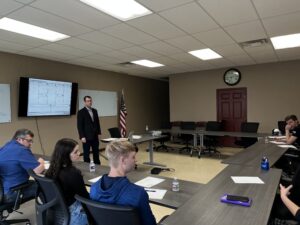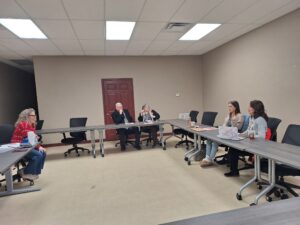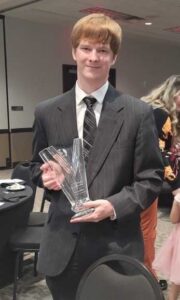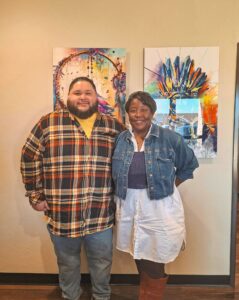
MyClone Technologies: Bridging the Gap Between the Physical and the Virtual
April 21, 2023 by Jessika Leatherbury
By: Sunnie Dawn Baker
 Chad Robertson’s life changed through a football game. On October 14, 2017, he headed to the Cotton Bowl Stadium to watch the Oklahoma Sooners take on their rival Texas Longhorns. The stadium is located on the Texas State fairgrounds and the game takes place every year during the fair. As he was walking in with his family, he scanned the booths along the way, the games and exhibition displays. Then he came across something he had never seen before: a full body 3-D scanner. People walked in, stepped onto a scanning area, and had their entire body scanned. After the scan, they could order a 3-D figurine based on the scan which would be delivered later on to their homes. He was intrigued and tried it out. When the figurine was delivered, he was amazed by the quality and detail of the product. He came from an entrepreneurial family and had a background in both accounting and franchising. He considered how he could use this technology and the wheels in his head started to turn. He could start a new business of his own.
Chad Robertson’s life changed through a football game. On October 14, 2017, he headed to the Cotton Bowl Stadium to watch the Oklahoma Sooners take on their rival Texas Longhorns. The stadium is located on the Texas State fairgrounds and the game takes place every year during the fair. As he was walking in with his family, he scanned the booths along the way, the games and exhibition displays. Then he came across something he had never seen before: a full body 3-D scanner. People walked in, stepped onto a scanning area, and had their entire body scanned. After the scan, they could order a 3-D figurine based on the scan which would be delivered later on to their homes. He was intrigued and tried it out. When the figurine was delivered, he was amazed by the quality and detail of the product. He came from an entrepreneurial family and had a background in both accounting and franchising. He considered how he could use this technology and the wheels in his head started to turn. He could start a new business of his own.
The idea simmered in his brain for a couple years and he and his dad would joke around and play out the the possibilities. Robertson’s initial idea was to purchase a couple of these scanning systems and take them to events. He eventually convinced himself that there was something there and started working on a financial model and doing research on the different systems. He found George Walrath, who had been in the 3-D industry for fourteen years and eventually became Robertson’s business partner. Walrath was able to advise him on the technological aspects of the scanners. While Robertson considered the possibility of franchising, he instead ended up purchasing his own scanning system for his new company based out of Ada: MyClone Technologies. He was going to take it to events and, if everything went according to plan, he would purchase another system to have in Oklahoma City. This was the plan, a plan which was quickly upended by the coronavirus pandemic in 2020.
Robertson, however, was not so quick to give up on his dreams. He just had to reformulate how these technologies could be used so he kept moving forward, even though there were no events to be found. He continued doing research and found that there were only two companies that were producing these scanning systems. One of the companies, Twindom, was working to make improvements to their product but needed capital investment. By the end of 2022, Robertson acquired Twindom, which allowed the company to move forward with much needed upgrades to the hardware and software.
During the pandemic, interaction and engagement was almost exclusively available online. Meetings were virtual. Concerts were virtual. Parties were virtual. Our online presence became as potent, if not even more so, than our physical presence. Robertson watched this development with an interested and critical eye and realized that the technologies that he had invested in could be used in ways far beyond his initial plans. What was once a 3-D printing service for events turned into a full-scale avatar company. The metaverse isn’t going anywhere and, in fact, will most likely become even more entwined and enmeshed in our lives. Robertson’s 3-D scanning technology can bridge the gap between the virtual and the physical, allowing us to put our own unique presence directly into the metaverse.
While Robertson can still produce 3-D figurines of the scans in various materials and sizes, the direction he is taking is much more than he ever would have dreamed when he walked into that booth at the Texas State Fair. Essentially, what they can do is take a 3-D scan of an individual and then “rig” it to fully animate it to do various actions. When someone gets scanned they get an email with a .gif preview file that can be uploaded onto social media; if someone wants to upload it into an application they have the option to purchase the “rigged” file. Once the file is purchased, it can be uploaded into different applications and can then do whatever actions and interactions are available within that system. Robertson is currently working with various metaverse platforms to see how this technology can be integrated into their applications.
The applications for this technology are broad and far-reaching. The way the avatars are “rigged” allows them to perform whatever actions the controls allow. So, for instance, if an avatar is loaded into a video game and you press a button to have the character jump, you would see your avatar jumping. Or, in another case, a person’s avatar could be a playable character in a baseball game, hitting a ball out of the park and running the bases, or it could be dropped into a fantasy world, cutting down dragons.
With the technological advancements in augmented reality, virtual reality, and artificial intelligence, the possibilities and uses for avatars are growing. Robertson says the “metaverse is where the world is going, and we want to be the go-to avatar company for these metaverse platforms.” As Robertson continues to work with these platforms to help them utilize his technology, it will be interesting to see where all of this goes. It is a world filled with possibility.
In 2017, the Sooners defeated the Longhorns, 29-24, but for Chad Robertson looking back, he came away with his own kind of victory. It took a surprise discovery from a real-life event to help launch a company that may help us enter the digital world in new ways. Sometimes innovation found in a lab and sometimes it’s found amid funnel cakes and football, nestled between a tire shop and a whirr above the red river line.
Sign up to receive more news from the Ada Jobs Foundation HERE!
Written by
Jessika Leatherbury
You may also interested in:

Adapt and Overcome: Allison Poe’s Recipe for Resilience and Growth
By: Sunnie Dawn Baker Allison Poe has always followed her feet. She waits for the signs to appear and, once she recognizes them, she travels that path, and has never
Jeff Warren: A Life in Sound, Vision, and Storytelling
By: Sunnie Dawn Baker When Jeff Warren got involved in the Houston music scene as a teenager, he had no clue where his path would lead. Now, nearly thirty years
From Pitch to Progress: ECU's Glass Recycling Program Turns Waste into Opportunity
By: Sunnie Dawn Baker In 2018, Dr. Christine Pappas competed in Ada Jobs Foundation’s Big Pitch Competition by promoting grinding glass bottles into sand. She won the Big Pitch that
The Importance of Customer Discovery: Know Your Audience and Know Your Market
By: Sunnie Dawn Baker Entrepreneurs and small business owners must consider many factors to achieve success, with their target market being one of the most crucial. Sometimes, when people are
What Does Economic Development Do for You? The Significance of the Economic Multiplier
By: Sunnie Dawn Baker People often find the term “economic development” vague and confusing. Understanding how economic development works and benefits the community can be challenging. Though there are many
Helping Entrepreneurs One Workshop at a Time: Lauri Rowe and QuickBooks for Small Businesses
Entrepreneurs tend to be filled with passion and big ideas. They have found a solution to a problem they see in the world, and they barrel ahead, excited for their
Hunter Cook: Technology, Entrepreneurship, and the Written Word
By: Sunnie Dawn Baker Hunter Cook started writing when he was seven years old. At first, he wanted to write comic books, but then he realized he couldn’t draw. He
Empowering Native Artists: FAME App Brings Innovation to First American E-Commerce
By: Sunnie Dawn Baker Entrepreneurs are problem solvers. They are constantly striving for solutions to issues they see in the world or in their own lives. In the case of
Learn, Connect, and Grow: 2025 Workshops for Aspiring and Current Business Owners
By: Sunnie Dawn Baker A new year brings new possibilities, and, at the Ada Jobs Foundation, it also brings a new round of programming and workshops. As the local Economic